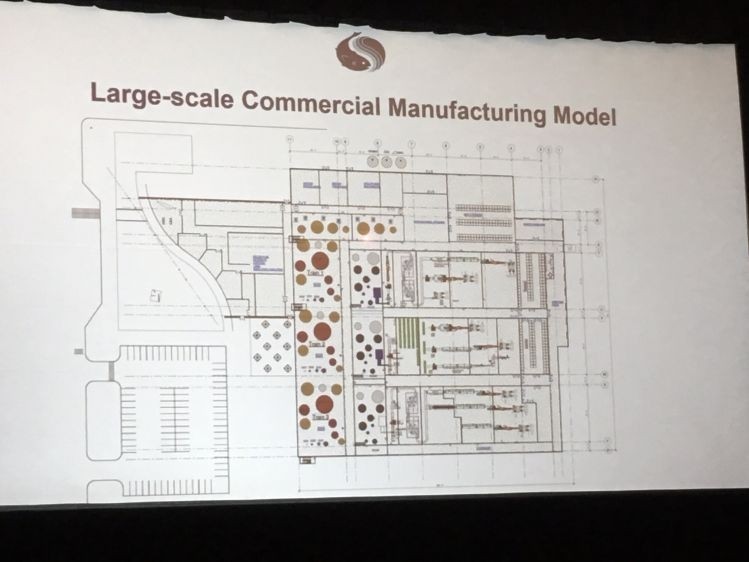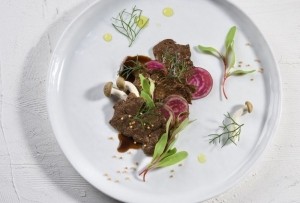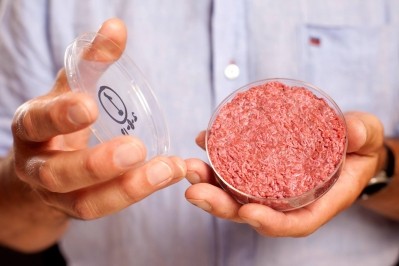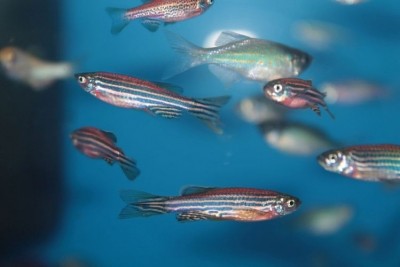From edible scaffolding to bio-printing: What would an industrial-scale cell-based meat plant look like?

While some start-ups such as Israeli firm Aleph Farms are focusing on growing 3D tissue on edible scaffolding upon which they are seeding multiple cell types to create thin strips of ‘steak,’ others are exploring techniques such as 3D bio-printing, said BlueNalu chief technology officer Chris Dammann PhD at the Industrializing Cell-Based Meats conference in San Francisco last week.
A cellular aquaculture start-up based in San Diego, BlueNalu has assembled a team with expertise in food innovation and tech commercialization, cell biology, tissue engineering, biomedical engineering, and bioprinting (which has previously been used in the medical field), Dr Dammann told FoodNavigator-USA.
“We’re not starting from scratch, we’re borrowing from existing technologies, biomedical printing and food printing. You can print cells and make organs; the challenges is doing it fast and at scale, but we have good concepts to do that, it’s high density printing and some people prefer to call it extrusion. It’s a pretty cool way to do it. The other solutions are elegant, but this technology will enable us to do this [produce cell-cultured meat] at a large scale.”
BlueNalu: ‘We will show how you can scale 3D bio-printing with cells and make really large structures’
Asked why, if the technique has promise for large-scale meat production, more companies in the field are not looking at it, he said: “If you say bio-printing, people think of this little tiny needle with micrometer resolution that would take forever, but there are methods… and we will show probably in 1-2 years how you can scale 3D bio-printing with cells and make really large structures. The technology is basically there. And this process lends itself well to fish tissue.”
So why might this be preferable to seeding cells onto an edible or/and biodegradable scaffold?
“If you want to grow thicker flesh there is a diffusion limit so the nutrients can’t reach all the cells, so you basically have to grow thin pieces or you need [something like] blood vessels in there to distribute the nutrients,” claimed Dr Dammann [although other players claim porous scaffolding that allows cell culture media to perfuse through it, or other biomaterials that can serve as vasculature could tackle this issue].

“In our case we are producing stable cell lines without genetic modification and would have separate bioreactors growing muscle cells, fat cells and connective tissue cells in FBS-free [fetal bovine serum-free] media and then you take the cells and [food-grade] bioink and print the meat and give it a curing time to settle and achieve more firmness,” said Dr Dammann.
“The bioink protects the cells but also has some components that provide structure and gelling.”
Referring to a mock-up drawing of a cell-based fish plant featuring 200,000 liter bioreactors, BlueNalu co-founder Lou Cooperhouse said:
“We don’t know [whether animal cells can survive the kind of fluid dynamics at play in a 200,000 liter tank], so that’s why we are looking at tiers of growth [pilot scale: 200 liters, test marketing manufacturing: 2,000 liters, regional market launch: 20,000 liters, large-scale commercial manufacturing 200,000 liters].”
“In 2013, the first cell-based meat burger had been produced, costing millions of dollars per pound. In 2015, Memphis Meats was founded, and with a bang, the industry began the race.
"Since then it has grown from one company in 2015 to almost forty in 2019: an almost forty-fold increase in under four years.”
Eric Schulze, PhD, VP of product and regulation, Memphis Meats
Aleph Farms: ‘The way we are seeding the cells onto the scaffold is unique to Aleph Farms’
Didier Toubia, co-founder and CEO of Aleph Farms, which unveiled the first cell-based ‘steak’ in December, told FoodNavigator-USA that the company had originally used a soy protein-based edible scaffold for prototypes in the lab, but envisaged using different [undisclosed] materials when the technology is deployed at the commercial scale.
“We’re currently working on two different [scaffolding] materials for the commercial phase,” said Toubia. “There will be some [of the edible scaffolding] remaining in the final product, and this will be required to be listed on the ingredients list, but it’s something natural and recognizable. The way we are seeding the cells onto the scaffold is unique to Aleph Farms.”
‘We’re currently working on non GMO methods to build our cell banks’
Asked about the cell lines and growth media that Aleph Farms is using, he said: “We’re currently working on non GMO methods to build our cell banks – we’re working with muscle, fat, blood vessels, and connective tissue and we’d like to have the four cell types – but we’re not there yet.”
So is producing animal fats from animal cells mission critical to the production of beef, and could plant-based fats be added instead? “We’re in the process of analyzing the importance of each cell type in terms of what’s definitely needed and it could be that some of the cells are not so critical in the end product,” said Toubia.
“Our growth medium is bovine serum free, but we have not yet finalized the formulation we’ll use in the commercial phase; we still need to improve the yield.”
So what’s the timetable?
“We’ll need two more years of development where we are validating a number of technologies until we reach an outcome that would meet the requirements for a commercial product,” he said.
“After two years we expect to have the production process refined, and then we’ll start building up the production capabilities after that. This would initially be in-house, and we’d expect to have a limited launch in three to four years, but this would be of limited quantities.”
Patents and investments in the cell based meat arena
Robert Yaman, chief operating officer at the International Alliance for Alternative Protein, said that despite all the hype, only around $75m had been invested in cell-based meat companies to date, whereas a single player in the plant-based meat space – Impossible Foods – had raised more than five times that amount.
As for intellectual property, after conducting a review of patents filed in this space, he found just 13 patents, from Modern Meadow (5), Memphis Meats (3), Just Inc (2), Integriculture (1), SuperMeat (1), and Future Meat Technologies (1).
That said, the field is moving incredibly fast, he said, so it is likely that considerably more patents have been filed over the past 18 months (patents filed since August 2017 have not yet become public as there is a delay between when a patent is filed and when it is published).
While one particular patent (Method for producing tissue engineered meat for consumption) acquired by Just Inc is pretty broad, it expires in 2022, he added.
GFI: ‘There is relatively little consensus on what this process might actually look like at production scale’
Companies are not sharing the details of their processes, but cell-based meat production typically involves a proliferation phase, whereby stem cells repeatedly divide to generate a large number of cells, perhaps in large stir tank bioreactors, and then a differentiation phase where they are triggered to differentiate into mature cell types and structures.
For example, myoblasts (precursors to muscle cells) divide and grow, then get ‘activated’ – for example by growth factors in the cell culture medium - to become mycocytes (muscle cells), which don’t divide, but just grow bigger, and then they can further differentiate and fuse into myotubes, which band together to make muscle fibers.

Liz Specht, PhD, senior scientist at the Good Food Institute, which promotes plant-based and cell-cultured meat, said that right now, however, there is “relatively little consensus on what this process might actually look like at production scale,” from the choice and management of cell lines (are most people working with induced pluripotent stem cells iPSCs, myosatellite cells, mesenchymal stem cells?); to the proliferation phase (single cell suspension? Cells types together or separate? Microcarriers? Aggregates?); the scaffolding phase (seed cells onto a solid scaffold? Mix scaffold with cells and polymerize, or don’t use scaffolding at all?); tissue perfusion (what thickness? Together or separate? How differentiate the cells?); and harvesting.
Reproducible and consistent cell lines are essential for cell-cultured meat production, but given that the cells used can in some cases divide and double almost indefinitely, companies will need to mitigate the risk of genetic drift and cryopreserve cells in master cell banks, vials from which can then be serially subcultured to produce working cell banks.
But right now, there are few publicly available cell lines of the requisite cell types for cell-cultured meat production, and far less public research funding compared with other related fields, said Dr Specht, who noted that the GFI has just awarded a series of research grants to academics and start-ups in the space.
“This is a critical moment for the industry and collaboration will dramatically accelerate the industry and ensure that private and public capital is used more efficiently.”
Asked about opportunities to collaborate, start-ups at the event told FoodNavigtator-USA that working together on regulatory issues made sense (there had been talk of an industry trade association last fall, although companies have been so busy that talks have not progressed much) but that collaborations in other areas might be more challenging.
Further reading:
- The ‘world is watching’ the cell-based meat industry, says Memphis Meats VP: ‘Subpar early products can stigmatize an entire category for decades to come’
- ‘Henry Ford did more for horses than animal rights activists ever did… technology has enabled us to align our ethics with our behaviors.’ Paul Shapiro talks cell-based meat


















